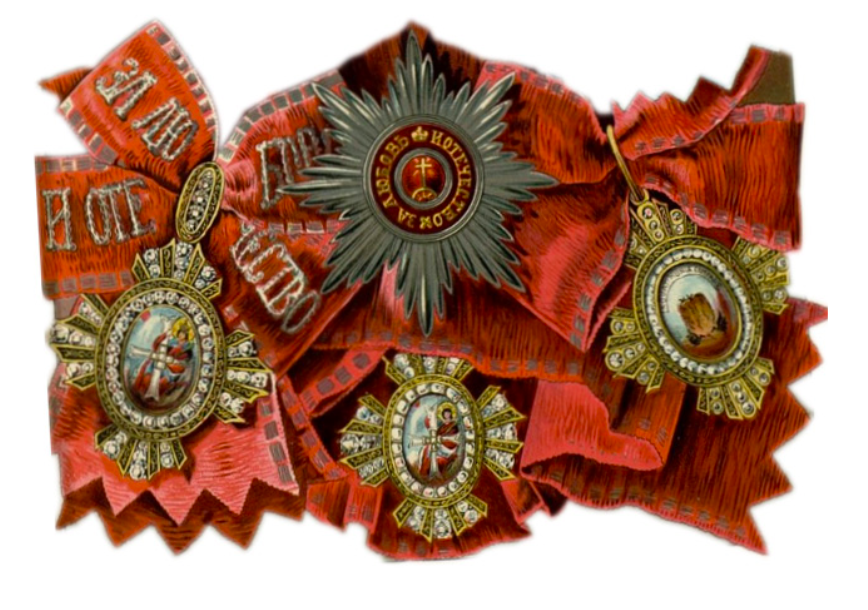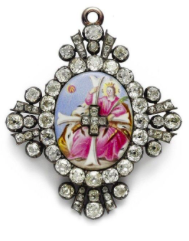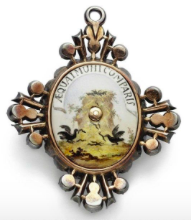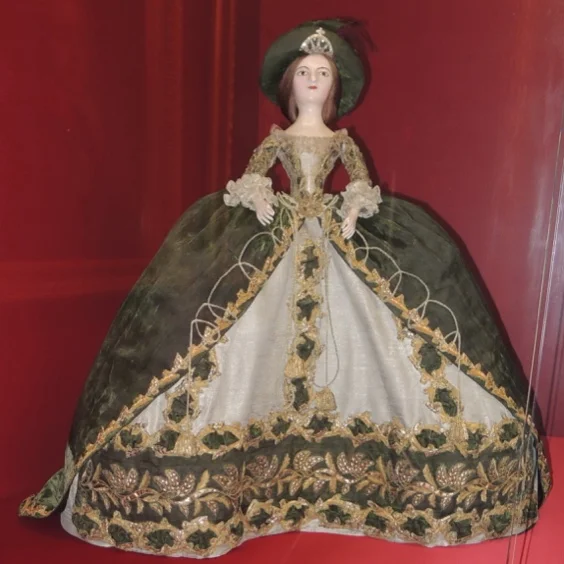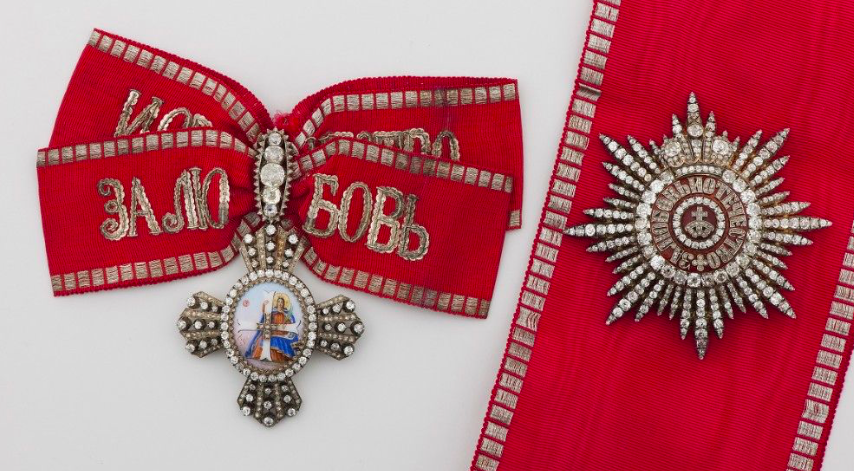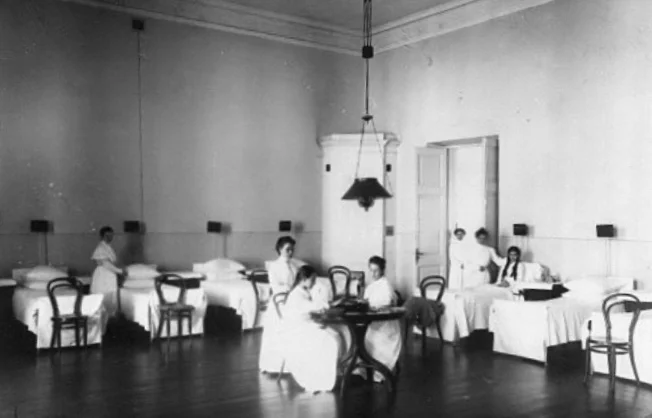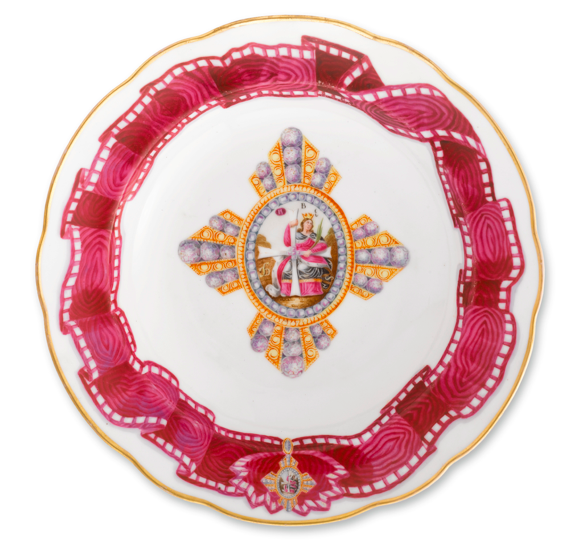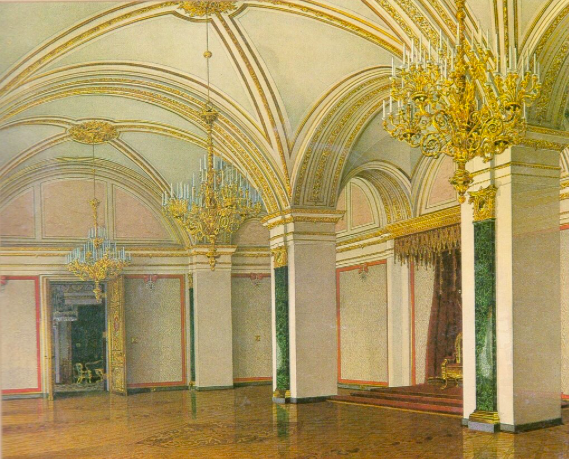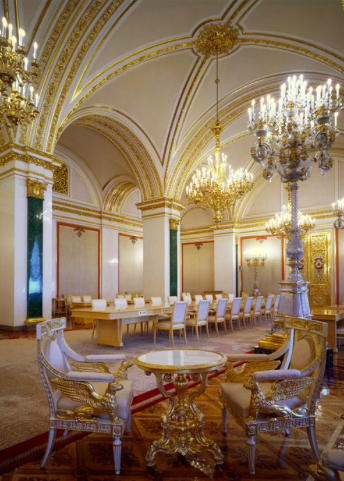A History of the Order of St. Catherine
by Nicholas B.A. Nicholson
This article was originally written as “A Brief History of the Order of Saint Catherine”
and was published on the Alexander Palace website
A 19th century Russian Icon of St. Catherine of Alexandria.
The Order of St. Catherine, the only chivalric order of the Russian Empire for women[I]was founded in 1714 in order to commemorate and immortalize the actions of Empress Catherine I, wife of Peter the Great, whose selfless 1711 sale of her jewelry and property to pay a ransom for Cossacks captured by the Turks earned her the admiration of both Court and country.
Statutes
The statutes of the Order were first published in 1713[ii], and on the 24th of November 1714, on the Empress' name day, Peter the Great personally bestowed the insignia of the Order upon the Empress Catherine, creating her Grand Mistress of the Order. The order was to be limited to "Persons of the feminine sex" and was given in two classes; The Grand Cross, which entitled the bearer to wear the star, ribbon, and badge of the Order, and the Small Cross, which entitled the bearer the right to wear the badge only. The badges were worn on the end of a red moiré ribbon trimmed with silver, with the sequined motto: "Za lyubov i otchestvo" (For love and the Fatherland)
Insignia
The Insignia of the badge of the order features at its center an enameled image of Saint Catherine in a white gown with a red cloak. In her right hand, the Saint holds a large white cross (a symbol of her faith) and behind her a large wheel (the symbol of her martyrdom). In her left hand, the Saint holds a palm frond. Over her head are her initials Sv. E (Svyataya Elizaveta) and between the arms of the cross, the letters D.S.F.R. (Domine Salvum Fac Regem, or, God Save the Tsar). On the obverse is an image of eagles destroying a nest of snakes at the foot of a ruined tower, at the top of which is a nest of eaglets. Above is the motto "Aequant Munia Comparis" (By her works she is to her husband compared). The Badges were 8.5 cm. high, and 7.5 cm. wide.
THE FRONT OF THE BADGE OF THE ORDER OF ST CATHERINE, GRAND CROSS
THE VERSO OF THE BADGE OF THE ORDER OF ST CATHERINE, GRAND CROSS
Each Russian Grand Duchess was conferred the Grand Cross of the order at her christening, and princesses of the Imperial Blood were invested upon attaining their majority at 18. Royal ladies who married into the Russian Imperial House received the Order immediately after their marriage. In addition to members of the Imperial Family, 106 women were allowed to be members of the order; 12 Dames Grand Cross, and 94 Dames Small Cross. Peter decreed that Catherine, and every subsequent Empress would serve as Grand Mistress of the order for life. Women elected to the order were so honored because of their philanthropic and charitable activities, as well as their noble birth, which was a requirement.
Queen Mary’s own set of the Order of St Catherine Grand Cross, Royal Collection Trust, London, IK
Unknown artist, Portrait of I.I. Volkov with the Badge of the Order of St Catherine, ca. 1835, collection of the state hermitage museum, St. Petersbrug
In a departure from the established rules, on February 5, 1727, Prince A.A. Menshikov was granted the Order of Saint Catherine "in tribute to his modesty". He was the only man ever to be so honored, and a portrait of him survives wearing the Order of St. Catherine. The Order also appointed male administrators, including a Chancellor, a Secretary, and two Heralds who were permitted to wear a smaller badge of the order on the left breast.
Later, the twelve Dames "Grand Cross" were female members of Foreign Ruling Houses. Queen Alexandra of Great Britain was made a Dame Grand Cross of the Order of Saint Catherine by Alexander II, Princess Alice of Greece (Prince Phillip's mother) was also a member of the Order. The 94 Dames Small Cross were women of the highest nobility, who were part of the Suite of the Empress that had made important philanthropic or charitable works. Only the death of a dame freed a place for a new member. As a result, with the exception of the members of the Imperial Family, the women of the Order were generally of advanced age. The Order was at its most popular (and had its highest turnover) in the mid nineteenth century. Nicholas I presented the Order to 176 women. In total, between 1714 and 1917, the Order was presented 734 times in both classes.
Robes of the Order
The Statute of April 5th, 1798 confirmed the appearance of the robes of the Order, which had undergone changes during the reign of Catherine II. Two dolls from the “Wardrobe of the Office of Orders”, (now preserved in the collections of the Kremlin Armory Museum, inv. No TK-3113/4) show the robes of the order in detail.
A diamond and ruby cap badge of the order of st catherine, state diamond fund of the Russian Federation, Moscow.
A brocade panniered gown with rouching, trim, and a train of green velvet embroidered heavily in gold was worn with a velvet cap, the upturned brim of which was decorated with a Catherine wheel and cross in gold braid. The grand mistress of the order had a wheel and cross in gold, set with diamonds and rubies. There exists today in the Diamond Fund of the Russian Federation, a unique diamond and ruby “Cap Badge” of the order in the form of the Catherine Wheel, surmounted by a diamond cross. The gown was the same for all members of the order, though the trains and embroidery were most elaborate for the Grand Mistress and the Deputy, then decreasingly so for the ladies of the first and second classes of the order.
On the 20th of October 1856, Alexander II made further modifications, and decreed that henceforth, the star and badges of the Order were to be diamond-set. Badges of the Grand Cross were brilliant-set, while those of the Small Cross were set with rose-cut diamonds set in gold filigree. There were plans for a Slavic revival modification to the robes of the order, as well as the creation of a collar chain for the members of the Imperial family, but these plans were never executed. After the “edict on court dress” was issued, ladies ceased to wear the 18th century robes of the order at all.
Dames of the first class wore approved court dress, with the sash (10mm wide) over their right shoulder, with the badge attached to a bow embroidered with the motto of the order at their waist. The star was worn on the left side of the breast. Women of the Small Cross wore the badge suspended from a bow (4.5 cm wide) on the left shoulder. Women were elected members of the Order by the Emperor, but their patents were signed by the Empress, who served as Grand Mistress. Since the Empress served as Grand Mistress for life, and so Empress Maria Feodorovna served as the last Grand Mistress of the Order before the Revolution. The honor of membership in the Order cannot be underestimated. Membership offered Dames of the Order complete access to the Imperial family, and a lifetime connection to them. When Alexandra Feodorovna and her daughters went into exile in Siberia, they took their badges and stars of the Order of St. Catherine with them. These were recovered in 1933, returned to Moscow, and disappeared.
The eight-pointed star of the order was 9 cm wide, made of silver, and set with diamonds. In the center, a silver cross rests on a scarlet enamel field, surrounded by gold letters reading in Russian "For Love and For the Fatherland"
A set of the Order of St. Catherine the Great Martyr from the norwegian Royal collections.
The Function of the Order
The Order was entirely responsible for the funding and administration of the two Catherine Institutes in St. Petersburg and Moscow, which were schools for young women of Noble Birth. Together with the Smolny Institute and a few other schools for women of noble birth, the Catherine Institutes constituted the finest educational institutions for women in the Empire.
The Catherine Institute, St. Petersburg
The School of the Order of Saint Catherine in St. Petersburg, naberezhnaya Fontanka, 36. Photo ca.1920.
Grand Duchess Maria Feodorovna in the order of st catherine, portrait by Alexandre Roslin, 1777, State Hermitage museum Saint Petersburg.
The School of the Order of St. Catherine in St. Petersburg was established on May 25, 1798 and was intended for the daughters of hereditary nobles who had an officer's rank or the corresponding level in the Table of Ranks. The educational institution was under the jurisdiction of the offices of Empress Maria Feodorovna, and it was funded almost entirely by the Order of St. Catherine. The school was designed by G. Quarenghi and constructed at 36 Fontanka Embankment.
History
On March 12, 1796, Emperor Paul I issued a decree obligating his spouse, Empress Maria Feodorovna, to “accept supervision over the educational school of noble maidens”. The following year, in a decree of May 2, the Emperor handed over to the Empress the schools "together with all the institutions belonging to them." After these ukazyof Emperor Paul I, Prince A. Kurakin called upon the “Cavalier Dames” of the Order of St. Catherine to support these schools as "a haven for noble girls without relatives, estates, or charitable support."
Prince Kurakin proposed that all the ladies who had received the insignia of the Order of St. Catherine under Emperor Paul, as well as those who would receive them in the future, would be obligated to make a one-time contribution to the school, and for their permanent maintenance, the “Cavalier gentlemen” of all the Russian Orders married to a member of the Order of St. Catherine should donate annually an amount at their discretion.
Maria Feodorovna later wrote a letter to Prince A. B. Kurakin that she was honored by her new duties, and “as the Grand Mistress of the Order of St. Catherine, will set an example in commendable and useful works on behalf of the fatherland.” The Empress determined that from her own income, she would grant 4500 rubles to the school she founded.
The grand opening of the school was held on June 12, 1798. Originally, the school was located in a wooden house opposite the Tauride Palace, from where it was transferred to a stone house on Vladimirskaya Street, bought from merchant Loginov. Later, Emperor Alexander I granted a plot of land with a dilapidated Italian Palace on the Fontanka embankment for the construction of the school building. In May 1802, the school moved to a one-story house on the designated site. The old palace was demolished, and in 1804-1807. under the project of architect Giacomo Quarenghi, a grandiose building in the neoclassical was built, facing the Fontanka embankment.
In 1828, after the death of Empress Maria Feodorovna, Emperor Nicholas I signed a decree, in accordance with which he assumed responsibility for this educational institution, continuing the work of his mother. For this, the IV Division of His Own Imperial Majesty's Office was created. In 1840, the composer M. I. Glinka wrote the vocal-symphonic work “Farewell Song of the Students of the Catherine Institute” to the words of P. G. Obodovsky. This work was traditionally performed as an anthem at the closing festivities of each graduation ceremony.
Young ladies of the catherine institute, Saint Petersburg, in their dormit0ry rooms, ca. 1900.
In 1844, the School of the Order of St. Catherine was officially assigned as one of the first (highest) category of women's institutions, which provided the elite a “decent education for the nobility.” The program included teaching the Law of God [Zakon Bozhii], the Russian language and literature, French, German, history, geography, natural sciences, hygiene, physics, cosmography , mathematics, drawing, penmanship, needlework, choral singing, gymnastics, dance, music (solo singing, ensemble singing, playing musical instruments, including in the ensemble), etiquette, and various types of home economics .
The Church of the Order
The spartan chapel of the Order of St. Catherine in the Catherine instutute on the fontanka canal, ca. 1900/
In 1845, the Church of St. Catherine the Great Martyr, was designed and built within the building of the Catherine Institute and acquired the status of chief Church of the Order.
The status of the Church as the seat of the Order was confirmed in the statutes[iii]
In 1854, the institute entered the Office of Institutions of Empress Maria Alexandrovna. From 1895, the St. Catherine School began annually to produce pupils who graduated from two-year classes and passed the exams for the right to work as home teachers. "Teachers", during training, wore a red sash (in the color of the ribbon of the Order of St. Catherine) as an honorary distinction.[iv]
The Catherine Institute, Moscow
The catherine institute, Moscow, photograph taken 1903 during the cententary celebrations of the order school.
The Moscow Catherine Institute of Noble Maidens was founded in 1803 on the initiative of Empress Maria Feodorovna and organized as an identical counterpart of the Catherine Institute created earlier in the western capital of St. Petersburg
According to the original charter, the Catherine Schools accepted only young ladies from disadvantaged noble families to study, but in 1804 the Empress created a department for bourgeois girls from other classes (burghers, merchants, daughters of the clergy etc.).[v] The bourgeois division existed until 1842, when it was removed and combined with an independent women’s school, which became known as the Alexandrovsky Women's Institute, located at Novaya Bozhedomka, was opened in 1891.
The building where the Moscow Catherine Institute was located originally belonged to Count Saltykov, who built himself a “country court” set within a park. In 1777, the property was taken over by the Imperial Treasury to settle debts of Saltykov, and an invalid home was opened there for officers and soldiers with a “home” church.
By the time of the repurposing of the building as the Catherine Institute, the house was substantially rebuilt in 1802-1803 by architect I. D. Gilardi. During the War of 1812, and the Great Fire of Moscow, the building was damaged, and so in 1826–1827, Domenico Gilardi and A. G. Grigoriev reconstructed it in the forms of late classicism.
In 1830, September 14, Metropolitan Philaret consecrated the Church of St. Catherine the Great Martyr which was located in the western wing of the building.[vi]
Ceremonies of the Order
A Russian Porcelain Soup Plate with the Cross and Ribbon of the Order of St. Catherine, Popov Porcelain Manufactory, Gorbunovo, 1811-1860. sotheby’s New York, property from the collections of lily & Edmond J. Safra, 18 OCTOBER 2011, lot 21.
There was a “St. Catherine” porcelain service commissioned in the 1830’s, and clearly based on the Gardner order services, but it appears that there is no Imperial connection to the service. As members of the Imperial Orders were permitted to use images of the insignia for their personal use, the service was perhaps commissioned by a high-ranking dame of the Order. It has been suggested that the service was commissioned privately for the use of the ladies of the order at the Catherine Institute in St. Petersburg.
The Order met for a liturgy and a banquet every year on the Order's feast day (24th November).
Wearing the robes and insignia of the Order, the women of the Imperial Family, followed by the Dames Grand and Small Cross would lead a procession from the Order’s Church to a banqueting hall specially prepared for the occasion.
The Hall of St. Catherine in Moscow
The hall of Saint Catherine in 1849, a watercolor by K.A. Ukhtomsky.
In Moscow, the Hall of Saint Catherine in the Great Kremlin Palace was used for these gatherings, and also served as the Empresses' Throne Room.
The Hall of Saint Catherine in the great Kremlin Palace was designed by Konstantin Andreievitch Ton, and impresses because of the elegance of its proportions, rather than by its size. The ornamentation of the room took its clues from the robes and insignia of the order. The white ceiling and silver moiré walls contribute to the feeling of lightness in the room, and the walls are bordered by the scarlet ribbon of the order, the crosses set with large paste stones.
The Hall of st catherine as it appears today.
The elaborate doors of the hall are masterpieces of the metalworker's art and feature the star and badge of the order entwined by branches of gilded laurel. Also of note in the hall are two large crystal torchères, which were ordered specifically for this room. The pilasters and columns in this room are veneered in Malachite. Even today, the beauty and function of the Hall of Saint Catherine remain intact, as all foreign delegations and diplomats are received in this room.
After the Revolution
Dowager Empress Maria Feodorovna served as the Grand Mistress of the Order until her death in 1928, though there were no official observances of Order ceremonies after 1914, or between 1918 and the Dowager Empress’ death.[vii],
In compliance with the statutes, presentations of the Order continued within the Imperial Family in exile under Grand Duke Kirill, who became head of the Imperial House in 1918, and declared his headship in 1924. Though there was friction between Grand Duke Kirill and the Dowager Empress, this did not stop internal awards of the Order of St. Catherine which belonged to female members of the Imperial Family by right of birth.
A 16th birthday portrait of Grand Duchess Maria Vladimirovna wearing the order of Saint Catherine, madrid, 1971.
As members of the Imperial House received the order by right, the Order of St. Catherine went to Princess Nadezhda Petrovna (1918), Princess Nina Georgievna (1921), Princess Ksenia Georgievna (1923), Princesses Maria and Kira Kirillovna (on their elevations to the rank of Grand Duchess in 1924), and Princess Vera Konstantinovna (1926). Relative Princess Marina of Greece and Denmark was made a Dame Grand Cross on her marriage to the Duke of Kent (1934). Princess Catherine Ioannovna received her Order when she reached her majority in 1936. Princess Olga of Oldenburg was awarded the Grand Cross in 1938. Grand Duchess Leonida Georgievna received the award and became Grand Mistress upon her marriage to Grand Duke Vladimir Kirillovich in 1948. Their daughter Grand Duchess Maria Vladimirovna received hers at birth in 1954. Princess Eilika zu Leiningen recieved the order in (1965) and at the wedding of Grand Duchess Maria in 1976, her half sister Helena Kirby de Bagration, Countess Dvinsky, also received the order. Mme. Anastasia Shirinskaya (2007) was one of the only family members to receive the order in emigration.[viii]
Today, H.I.H. Grand Duchess Maria Vladimirovna of Russia has the right to award this Order. Because the statutes of the Order have been kept scrupulously observed without change, in emigration the Order is awarded only to women of the Imperial family, ladies of foreign Sovereign houses, and Russian ladies of the highest nobility that are in service to the Imperial House. Today Grand Duchess Maria Vladimirovna has been Grand Mistress of the Order since 2010, and since the death of Princess Eilika zu Leiningen in 2016, she and her half-sister Countess Dvinskaya are the order’s only members.
Notes:
[i]Excluding the Insignia of Saint Olga, given only in 1916-1917, and the Order of St. Anastasia, founded in exile by the Head of the Russian Imperial House. For more on the Order of St. Olga, please an article by Oleg Naumov here: https://rusplt.ru/society/odinokiy-orden-21944.html. For more on the Order of St. Anastasia, see here: http://www.saintanna.ru/?lang=rus&id=80
[ii]The Statutes of the Order of Saint Catherine (1898 ed.) may be read here [in Russian] http://george-orden.narod.ru/statut1892s02.html
[iii]Section 266: “The Order of St. Catherine was given a church in St. Petersburg in the name of St. Catherine the Great Martyr, located at the College of this Order, and the image of the order’s insignia placed above the main entrance to it. (Art. 15; 1845 Aug. 20 (19,294).)”
[iv]By decision of the Provisional Government of May 26, 1917, the Petrograd School of the Order of St. Catherine was transferred to the Office of the Ministry of State Charities , and in December 1917 - under the complete authority of the People's Commissariat of State Charities. On the basis of the decree of the Council of People's Commissars of June 5, 1918, the educational institution was transferred to the jurisdiction of the National Commissariat of Education. In the same year the school was liquidated and called “a bourgeois assault on the future of the Revolution.”
[v]This was similar to the successful structure of the famous Smolny Institute in St. Petersburg which had separate classes for girls of the nobility and girls from the other classes. At Smolny, these classes were ultimately combined, creating a more diverse group in each class, while at the Catherine Institutes the “bourgeois” divisions were eliminated.
[vi]Since 1928 the building housed first the Central House of the Red Army (now known as the Central House of the Russian Army).
[vii]Formal ceremonies were suspended during the Great War.
[viii]The history of the order in emigration may be read about here: http://www.saintanna.ru/?lang=rus&id=48
Read the Statutes of the Order HERE.
Bibliography
The majority of works on this topic are in Russian only. I recommend Michael Y. Medvedev’s excellent piece in English on this distinguished order, and refer readers also to Burke’s World Orders of Knighthood and Merit (eds. Guy Stair Sainty, R. Heydel-Mankoo) for his article on the order of St. Catherine the Great Martyr.
Энгельгардт А. Н. , Очерки институтской жизни былого времени. (Из воспоминаний институтки).- «Заря», 1870, № 8, С. 107—149; № 9,. С 3—65. Под псевдонимом — Вельская А. Ведомство учреждений императрицы Марии: Краткий исторический очерк… СПб.: 1912.
Карцов. Н. С., Несколько фактов из жизни Санкт-Петербургского училища Ордена Св.Екатерины. — СПб., 1898.
Масик, С. Н., Юбилейный LXX выпуск Екатерининского института благородных девиц. Санкт-Петербург, 1912 год. — СПб.: «Гамма», 2017.— 403 с.
Панкратьева, Е. Э., С.-Петербургское училище ордена святой Екатерины [Екатерининский институт]. 1798-1898: Исторический очерк и описание празднования юбилея Училища. — СПб.: тип. Е. Евдокимов, 1899. — 100 с.
Половцова Е. А. Екатерининский институт полвека назад. (Из воспоминаний бабушки). М.: Унив. тип., 1900. 50 с.
Московское училище ордена Св. Екатерины 1803-1903 гг.: Исторический очерк. Составлен по поручению Совета Училища Комиссией преподавателей под общей редакцией инспектора классов В.А.Вагнера. М., [печатня А.Снегиревой], 1903. VIII, [4], 560 с.; 3 л. портретов.
Please send your comments on this page to Nick Nicholson

